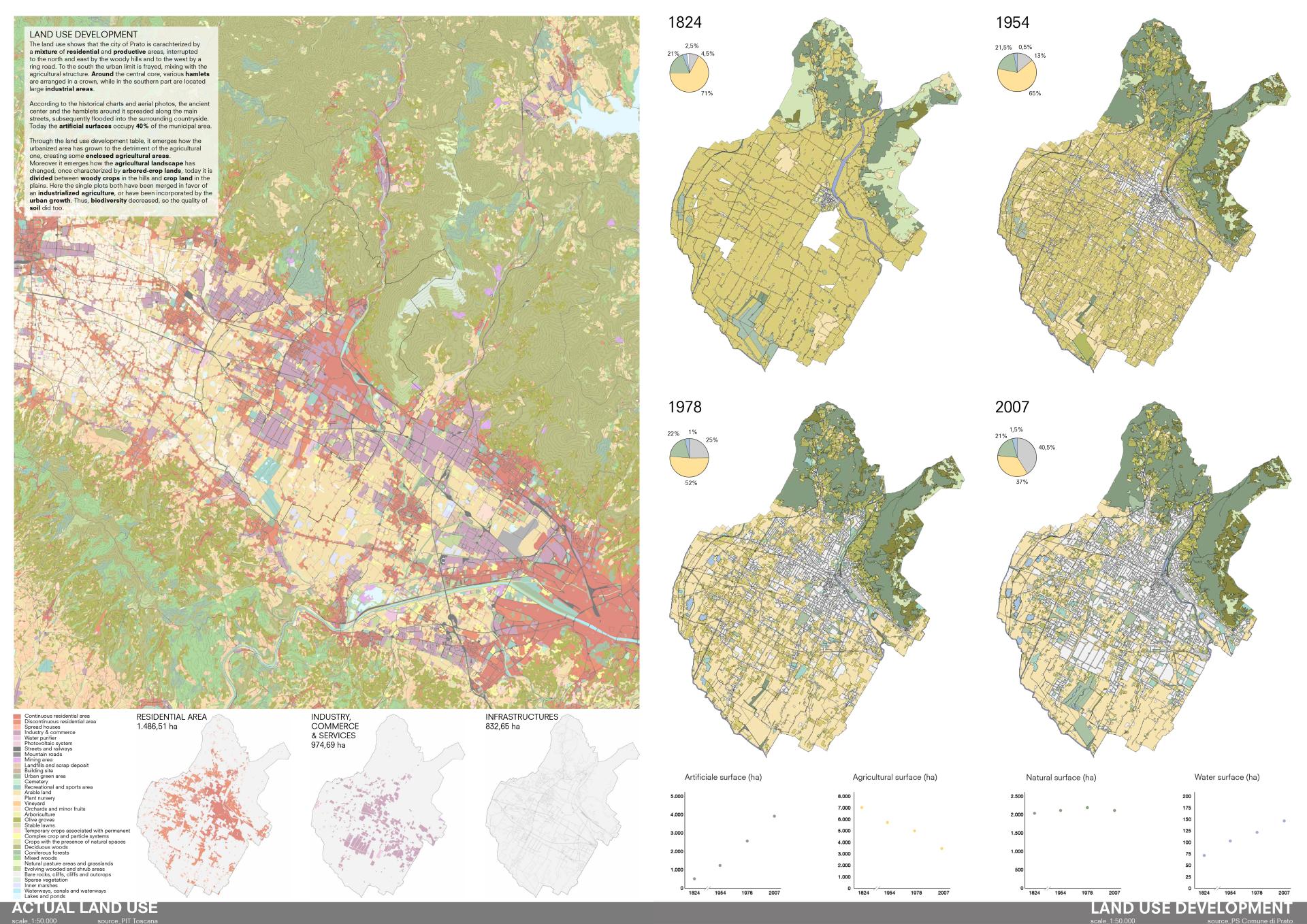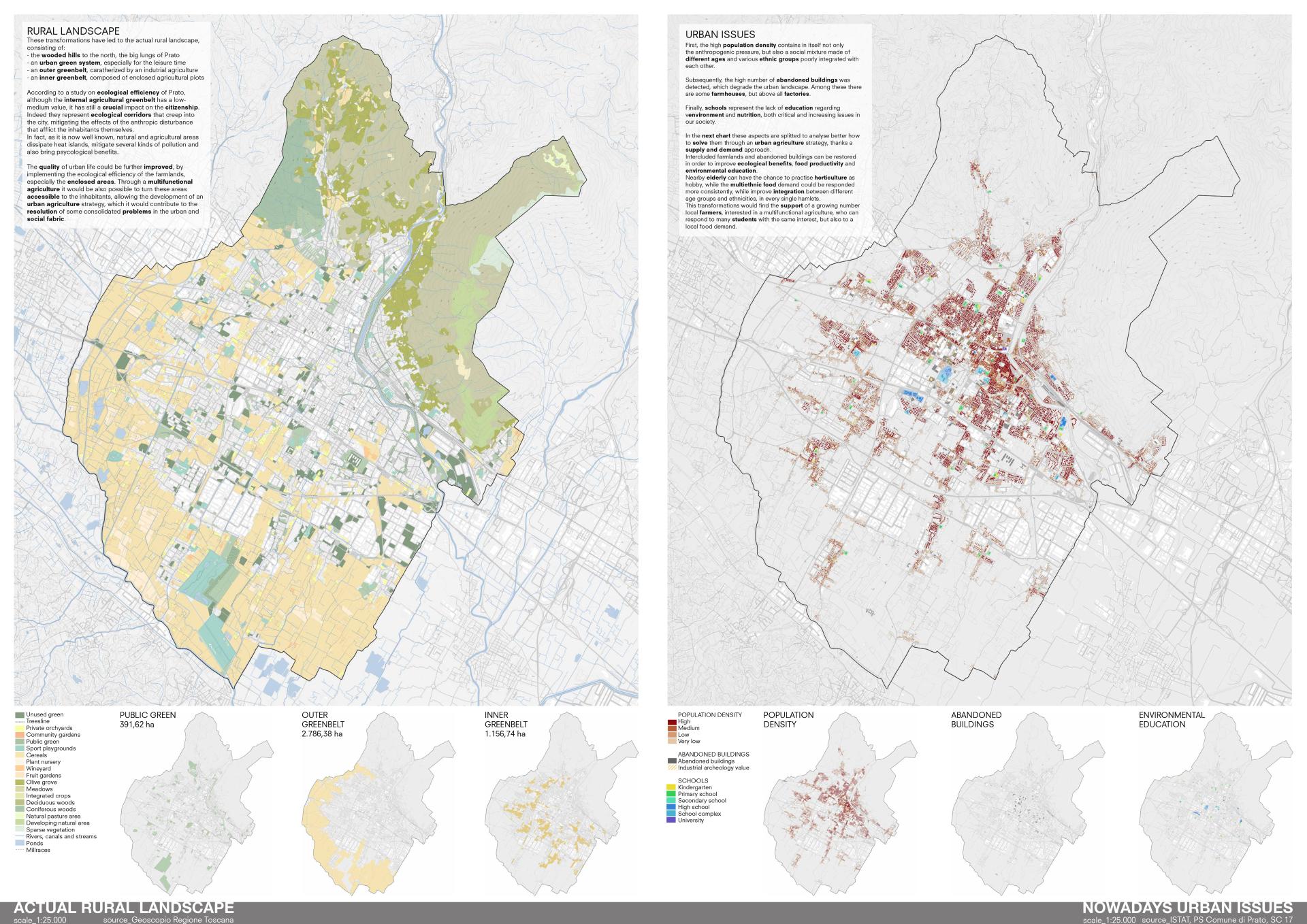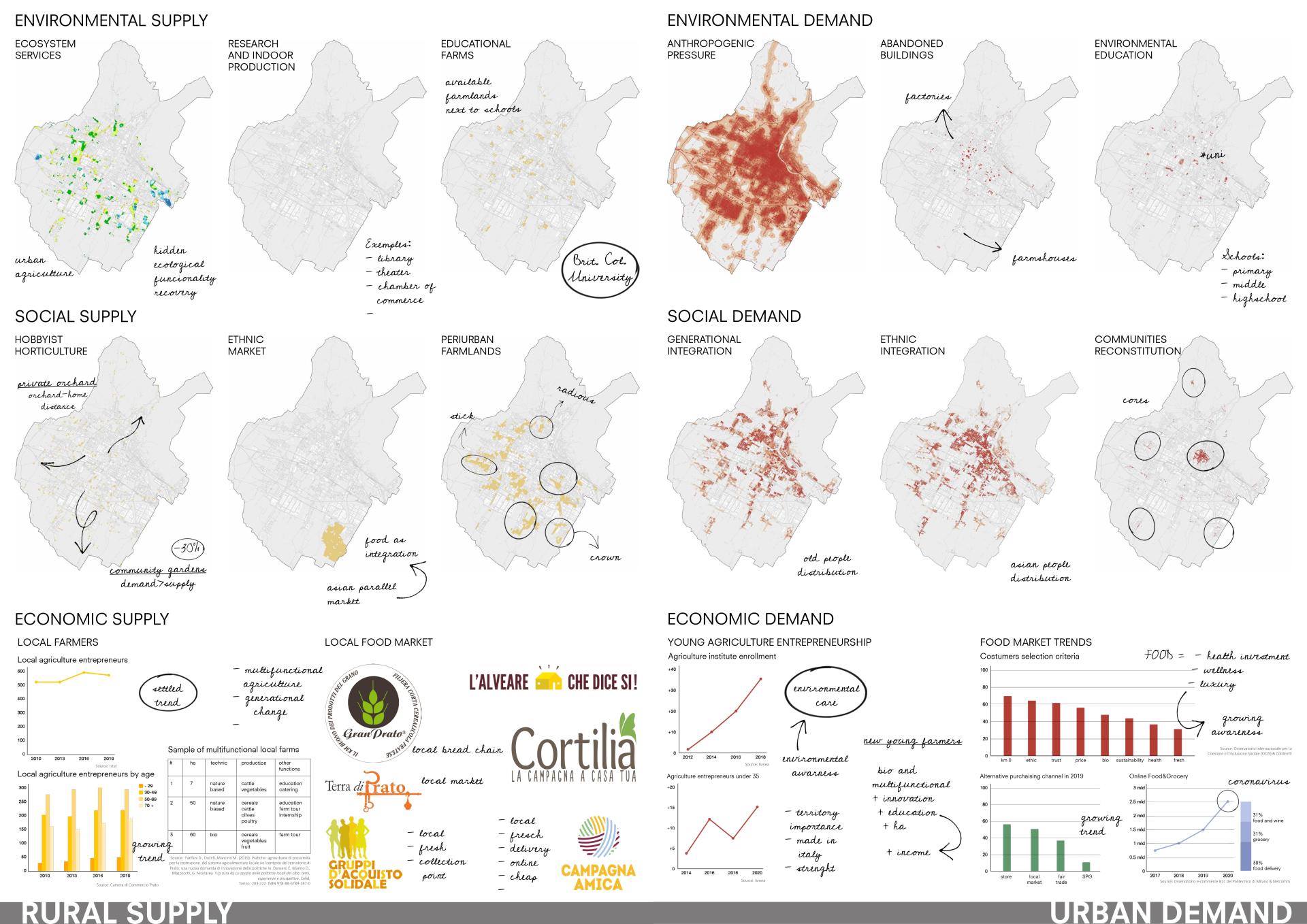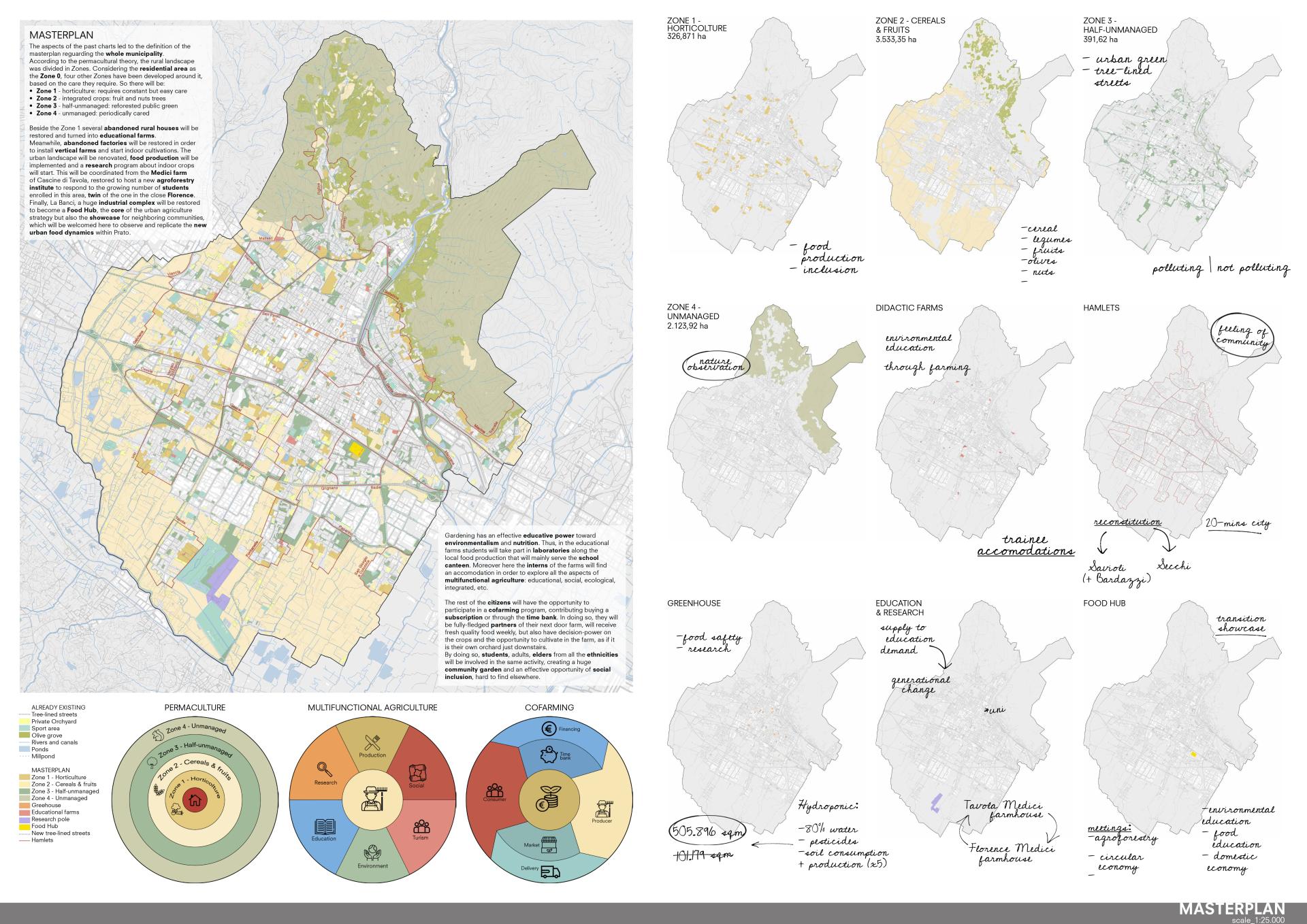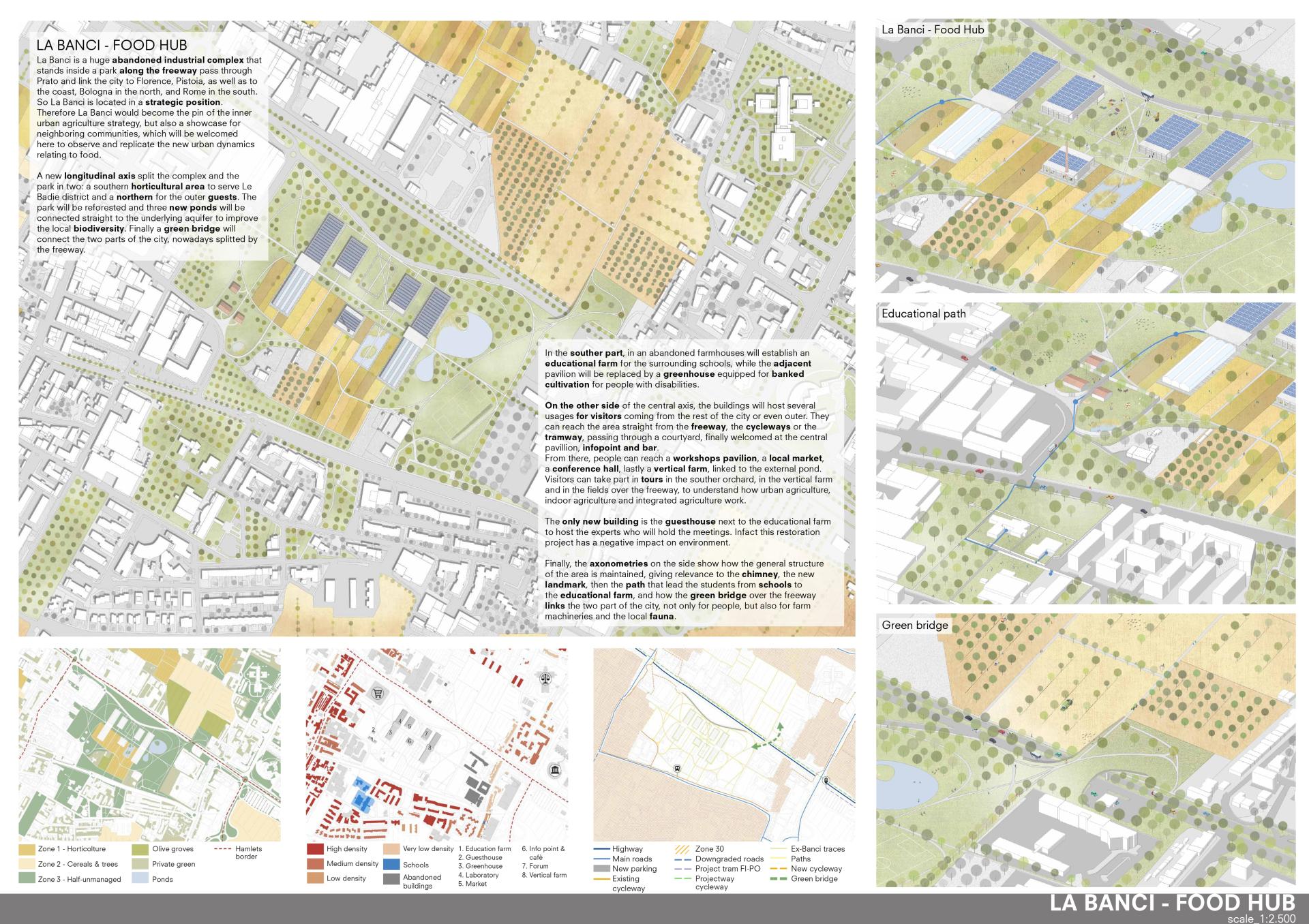Prato Food Factory
Basic information
Project Title
Full project title
Category
Project Description
The food system is one of the most polluting industry of our society. On the other hand, food can reconnect people and nature! By combining professional agriculture and amateur urban gardening, it is possible to improve the self-sufficiency of a community, but also have environmental and social benefits, such as: less polution and packaging, biodiversity improvement, heat island reduction, health improvement, social cohesion among different ages and ethnicities, food and environmental education.
Geographical Scope
Project Region
Urban or rural issues
Physical or other transformations
EU Programme or fund
Which funds
Description of the project
Summary
Prato is a medium sized city characterised by a polycentric urban structure. The central core is surrounded by many hamlets that merge with the outer agricultural belt. The result is a city with inner agricultural islands, cultivated with wheat, following an industrial approach in a long supply chain strategy. Nevertheless, these open areas still ensure the inhabitants fundamental ecosystem services, such as pollution and heat islands mitigation. According to agroecology, these can be enhanced by diversifying the cultivations, introducing horticulture crops and using natural treatments. This will also improve biodiversity and provide more local fresh food to the citizens.
In order to do so, the whole territory is redesigned, adapting the Permaculture Zones this specific territory. The Zone 0 coincides with the residential areas, next to which there is the Zone 1, dedicated to horticulture. Further the Zone 2 is cultivated with cereals and tree crops. The Zone 3 is half-managed, which coincides parks and green areas. Finally, the Zone 4 is the unmanaged one, that includes the northern hills.
By moving food production within the city, it is possible to benefit from the multifunctionality of agriculture. In fact, agricultural islands inside Prato will be classified Zone 1 and these will be managed by farmers through a community sustained agriculture system. So, people can buy fresh food by paying it or by taking part to the daily farm activities. Therefore, every farm will turn in huge urban gardens where people will gather to produce their own food and create social cohesion in every hamlet of the city.
Finally, some abandoned rural houses near the Zone 1 will be restored and turn into educational farms to start environmental and food education for students. On the other hand, several abandoned factories will turn into vertical farms to improve the self-sufficiency in term of food and develop research programs on indoor cultivation.
Key objectives for sustainability
Nowadays the agri-food sector is unsustainable. It is polluting, it exploits workers and resources, finally it produces low quality food. Agriculture must be environmentally, socially and economically sustainable. We must change our food production policies toward an ecological, local and multifunctional agriculture.
According to an agroecological approach, it is fundamental to create intecropping and promote vegetable gardens, rather than industrial cereal production, in order to enhance soil regeneration, biodiversity and ecological services, such as nutrient food production.
The improvment of urban greenery in the Zones 1, 2 and 3 will contribute to heath island and pollution reduction.
Finally, a local food production would reduce pollution from transportation, packaging and pests, as well as food waste and food loss along the present fragile long-chain.
This project has also a long-term positive environmental impact. In fact, within the Zone 1, students and people in general can understand the importance of the natural environment. In fact, it is proven that agriculture gives the chance to get in touch with nature through a give and take relationship. People take care of plants in exchange for food. This is such a powerful investment in future generations!
Key objectives for aesthetics and quality
According to the permaculture principle, the territory of Prato is divided into different Zones, based on the care that the cultivations need, in order to create a permanent productive landscape around the settlement, integrated with nature.
So, the Zone 0 represents the residential area, the Zone 1 is dedicated to horticulture, that needs a everyday care. The Zone 2 is cultivated with cereals and tree crops. The Zone 3, half-managed, includes parks and urban green in general, where a reforestation strategy would start. Finally, the Zone 4, unmanaged, coincides with the hills in the north, where man goes to hike, meditate, or observe nature to learn from it.
The result is a rural landscape that frequently varies. There will be vegetable gardens and parks nearby the residential areas, the outer arboriculture landscape in the south-west and the woody hills in the north. The variety of the landscape corresponds to a wider range of biodiversity. The inhabitants of Prato would enjoy both these aspects, thanks to an integrated web of cycleways that runs across this new rural landscape that would connect all the parts of the city. In addition, people could move safely on this track by bike or by foot, far from the urban traffic.
Meanwhile, also the urban landscape would be regenerated. Abandoned farmhouses nearby the Zone 1 would turn into educational farms to host both school students and the interns of the farms. On the other hand, several abandoned factories would become vertical farms to integrate the food production within the city and start a diffuse research program on indoor cultivations. By doing so, not only the buildings themselves, but the entire areas would turn from degraded into requalified, accessible and livable, in order to provide people better places where to stay or just pass by. While in terms of experience, people will enjoy the agriculture tasks and the real fresh taste of their own products.
Key objectives for inclusion
The farms in the Zone 1 will adopt a Community Supported Agriculture strategy. This gives people the opportunity to subscribe and pay a monthly membership cash or fill a time bank account by taking part to the agricultural tasks. So, the customers will turn into prosumers, actual part of the company. In return they will receive seasonal fresh food every week. Moreover, they will have decision power on what to cultivate. According to the multiethnicity of Prato, it will be possible to create multi-ethnic vegetable gardens where to intercrop different plants from the different cuisines, in order to create social inclusion.
This strategy also give people passionate in horticulture an orchard where to practice their hobby near their house. Especially, this meets the rising demand of elders in search for urban gardens. On the other hand this can temporary help also the poorest, or even jobless people. Local agriculture is convenient for everyone!
Old farms nearby the Zone 1 will be restored and turn into educational farms, where school students would have the possibility to get in touch with nature to improve their knowledge in scientific subjects and overall receive an environmental and food education. Here also higher education students will have the chance to find an internship in their field: agriculture, education, economy, etc.
Thereby, every hamlet would achieve various grades of social cohesion. Firstly, through a CSA strategy, between costumers and producers, who will be free from the GDO system. Secondly, inter-generational and multi-ethnic integrations by gathering students, elders, farmers, but also different ethnicities around food production. Finally, people would rediscover the cohesion with nature and, according to science, agriculture is actual the easiest instrument do make people understand how our actions can affect the planet, both in a negative and a positive way.
Physical or other transformations
Innovative character
These three dimensions will be combined by urban agriculture. In environmental terms, an agroecological approach would regenerate soil and biodiversity, reduce pollution, enhance ecological services and guarantee nutrient food. Moreover, a local food production would reduce pollution from transportation, packaging and pests, as well as food waste and food loss. Finally, according to scientific papers, urban agriculture allow students and people in general to get in touch with nature and understand the importance of the surrounding environment.
By gathering people through common tasks in touch with nature, urban agriculture also contribute to social cohesion and inclusion, unlike the actual food supply chain. In fact, the areas under the Zone 1 will turn into huge community gardens where people from different ages, social classes and diverse ethnicities will meet. Moreover, elders can practice horticulture as a hobby next to their house, while students can get aware of nature and its importance. Finally, the CSA strategy will give the opportunity to pay or to work in the farms in order to receive buy local fresh food.
The variety of nature is recognized as objective beauty. By regreening our cities, thanks to the different Permaculture Zones, it will be possible to get in touch with various and colorful natural landscapes, by simply moving throughout the city. It will be possible to get in touch not only with vegetable gardens, but also with urban forests, golden wheat fields, or colorful meadows. This is the kind of beauty that positively influence our mental health.
This project is exemplary because the target is not to design a few new urban gardens, but the development of a complex urban agriculture strategy on a urban scale. In fact, several aspects were took in account, such as self-succency, social cohesion, aesthetic, etc. Finally, the whole strategy is applied by adapting the permaculture principle of Zones to a medium-sized city.

